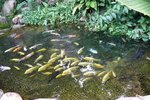Things You'll Need
Floating pond pellets
Automatic feeder
Pond feeding ring
Pond aerator
Piece of thin rope, approximately 25 feet long
Pond thermometer
Many pond owners supplement the natural food sources in ponds by feeding their fish high-protein pellets. Pellet fish food boosts growth rates; for every 2 lbs. of pellet food that you provide, the fish will collectively gain 1 lb. Well-managed ponds typically double their production of bluegills if you feed them pellets as a supplement. Since pellet food results in higher metabolic waste, you should not feed bluegills in a pond in excess of 20 lbs. of pellet fish food daily, per surface acre.
Choose a floating fish pellet that contains between 28 and 32 percent digestible protein. Ensure that the main ingredient is fish meal.
Position and secure a directional automatic feeder at the edge of your pond, or on a jetty overlooking the water. Automatic feeders that operate on solar panels are an alternative to battery powered units.
Feed your bluegills by hand as an alternative to using an automatic feeder, if you wish. Feed at the same location and at the same time each day.
Place a pond feeding ring on the surface of the water and secure it with a piece of thin rope tied to a tree or to your jetty. Throw the floating pellets into the ring; this prevents the wind from blowing them into reeds or against the bank. Obtain a ring from your aquatic dealer.
Feed only during daylight hours. Don't provide food before sunrise or after sunset, as the fish will not come to the surface and the uneaten food will pollute the pond.
Install a pond aerator, as supplementary feeding causes bluegills to produce additional metabolic waste. This waste consumes oxygen when bacteria in the water breaks it down.
Feed only when the water temperature is between 60 and 90 degrees Fahrenheit. Use a floating pond thermometer to measure the temperature. You can continue to feed during the fall provided the temperature doesn't drop below 60 degrees Fahrenheit.
Feed the fish twice a day, once in the morning and once in the afternoon.
Feed only an amount that the fish will eat within 10 to 20 minutes.
Check the automatic feeder periodically, if you are using one, to ensure that it is in working order.
Store the pellets indoors and at a temperature below 75 degrees Fahrenheit.
References
Writer Bio
Virtually growing up in a computer repair shop, Naomi Bolton has held a passion for as long as she can remember. After earning a diploma through a four year course in graphic design from Cibap College, Bolton launched her own photography business. Her work has been featured on Blinklist, Gameramble and many others.



